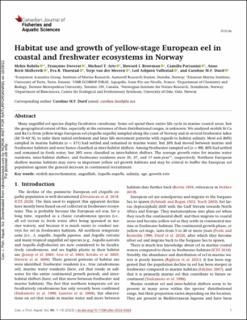Habitat use and growth of yellow-stage European eel in coastal and freshwater ecosystems in Norway
| dc.contributor.author | Rohtla, Mehis | |
| dc.contributor.author | Daverat, Françoise | |
| dc.contributor.author | Arts, Michael T. | |
| dc.contributor.author | Browman, Howard | |
| dc.contributor.author | Parzanini, Camilla | |
| dc.contributor.author | Skiftesvik, Anne Berit | |
| dc.contributor.author | Thorstad, Eva Bonsak | |
| dc.contributor.author | van der Meeren, Terje | |
| dc.contributor.author | Vøllestad, Leif Asbjørn | |
| dc.contributor.author | Durif, Caroline | |
| dc.date.accessioned | 2022-12-01T10:22:54Z | |
| dc.date.available | 2022-12-01T10:22:54Z | |
| dc.date.created | 2022-11-04T15:00:53Z | |
| dc.date.issued | 2022 | |
| dc.identifier.issn | 0706-652X | |
| dc.identifier.uri | https://hdl.handle.net/11250/3035272 | |
| dc.description.abstract | Many anguillid eel species display facultative catadromy. Some eel spend their entire life cycle in marine coastal areas, but the geographical extent of this, especially at the extremes of their distributional ranges, is unknown.We analysed otolith Sr:Ca and Ba:Ca from yellow-stage European eel (Anguilla anguilla) sampled along the coast of Norway and in several freshwater lakes (58◦N–63◦N), to infer their initial settlement and later life movement patterns with regards to habitat salinity. Most eel (80%) sampled in marine habitats (n = 371) had settled and remained in marine water, but 20% had moved between marine and freshwater habitats and were hence classified as inter-habitat shifters. Among freshwater sampled eel (n = 99), 80% had settled and remained in fresh water, but 20% were classified as inter-habitat shifters. The average growth rates for marine water residents, inter-habitat shifters, and freshwater residents were 35, 27, and 17 mm·year–1, respectively. Northern European otolith microchemistry, anguillids, Anguilla anguilla, salinity, age, growth rate | |
| dc.language.iso | eng | |
| dc.title | Habitat use and growth of yellow-stage European eel in coastal and freshwater ecosystems in Norway | |
| dc.title.alternative | Habitat use and growth of yellow-stage European eel in coastal and freshwater ecosystems in Norway | |
| dc.type | Peer reviewed | |
| dc.type | Journal article | |
| dc.description.version | publishedVersion | |
| dc.source.journal | Canadian Journal of Fisheries and Aquatic Sciences | |
| dc.identifier.doi | 10.1139/cjfas-2022-0033 | |
| dc.identifier.cristin | 2069354 | |
| dc.relation.project | Norges forskningsråd: 280658 | |
| dc.relation.project | Havforskningsinstituttet: Coastal Ecosystems Program | |
| cristin.ispublished | true | |
| cristin.fulltext | original | |
| cristin.qualitycode | 2 |
Tilhørende fil(er)
Denne innførselen finnes i følgende samling(er)
-
Articles [3016]
-
Publikasjoner fra CRIStin [3074]
